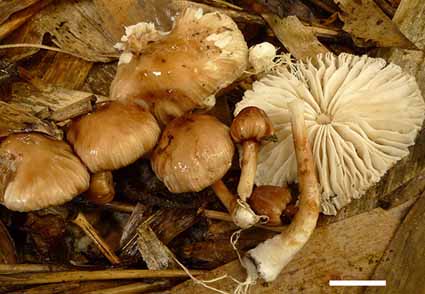Abstract
Two new taxa of Zhuliangomyces, Z. bambusus and Z. terrus, from Hainan Province of China, a tropical region, are proposed based on morphology and molecular systematics. Zhuliangomyces bambusus is characterized by its light brown basidiomata with a grayish tone at age, striate pileus margin, a viscid annulus, predominantly subglobose basidiospores, abundant clamp connections, and habitat in bamboo duff. Zhuliangomyces terrus possesses a chocolate or dark brown pileus when young, brown to pale brown when mature, a non-striate pileus margin, a viscid annulus, predominantly broadly ellipsoid basidiospores, plentiful clamp connections, and it fruits on soil. These two new species are distinctive from related species in the genus Zhuliangomyces, forming two well-supported monophyletic lineages in the phylogenetic tree of the concatenated dataset of ITS-LSU. This is also the first time that the genus is found in tropical China. A key to this genus is also provided.
References
<p>Corner, E.J.H. (1994) Agarics in Malesia. I. Tricholomatoid. II Mycenoid. <em>Beihefte zur Nova Hedwigia</em> 109: 1–271.</p>
<p>Cui, Y.Y., Cai, Q., Tang, L.P., Liu, J.W. & Yang, Z.L. (2018) The family Amanitaceae: molecular phylogeny, higher-rank taxonomy and the species in China. <em>Fungal Diversity</em> 91: 5–230. https://doi.org/10.1007/s13225-018-0405-9</p>
<p>Earle, F.S. (1909) The genera of the North American gill fungi. <em>Bulletin of the New York Botanical Garden</em> 5: 373–451.</p>
<p>Edgar, R.C. (2004) MUSCLE: multiple sequence alignment with high accuracy and high throughput. <em>Nucleic Acids Research</em> 32: 1792–1797. https://doi.org/10.1093/nar/gkh340</p>
<p>Ferreira, A.J., Wartchow, F. & Cortez, V.G. (2013) <em>Limacella ochraceolutea</em> (Agaricomycetes) in the Atlantic Forest of southern Brazil. <em>Field Mycology</em> 14: 64–67. https://doi.org/10.1016/j.fldmyc.2013.03.009</p>
<p>Franco-Molano, A. (1991) <em>Catatrama</em> (Tricholomataceae), a new genus from Costa Rica. <em>Mycologia</em> 83: 501–505. https://doi.org/10.1080/00275514.1991.12026040</p>
<p>Gminder, A. (1994) Die trockenstieligen Arten der Gattung <em>Limacella</em> in Europa. <em>Zeitschrift für Mykologie</em> 60: 377–398.</p>
<p>Guzmán, G. & Johnson, P.D. (1974) Registros y especies nuevas de los hongos de Palenque, Chiapas. <em>Boletín de la Sociedad Mexicana de Micología</em> 8: 77–105.</p>
<p>Hall, T.A. (1999) BioEdit: a user-friendly biological sequence alignment editor and analyses program for Windows 95/98/NT. <em>Nucleic Acids Symposium Series</em> 41: 95–98.</p>
<p>Hosen, M.I. & Li, T.H. (2017) First report of <em>Limacella</em> from Bangladesh, with a new species description. <em>Phytotaxa</em> 332: 280–286. https://doi.org/10.11646/phytotaxa.332.3.4</p>
<p>Imazeki, R., Otani, Y. & Hongo, T. (2011) Fungi of Japan (Revisied and enlarged edition). Yama-kei Publishers Co., Tokyo</p>
<p>Kornerup, A. & Wanscher, J.H. (1981) <em>Taschenlexikon der Farben</em> (3rd ed.). Zürich und Göttingen: Muster-Schmidt Verlag.</p>
<p>Kühner, R. (1926) Contribution à l’étude des Hyménomycètes et spécialement des Agaricales. <em>Botaniste</em> 17 (1–4): 1–224.</p>
<p>Lasch, W.G. (1828) Enumeratio Agaricorum Marchiae Brandenburgicae, nondum in floris nostratibus nominatorum, cum observationibus in cognitos et novorum descriptionibus. <em>Linnaea</em> 3: 153–162.</p>
<p>Maire, R. (1926) Études mycologiques (fascicule 2).<em> Bulletin de la Société Mycologique de France</em> 40 (4): 293–317.</p>
<p>Murrill, W.A. (1914) <em>Limacella. North American Flora</em> 10 (1): 40–42. https://doi.org/10.1038/scientificamerican07181914-42asupp</p>
<p>Neville, P. & Poumarat, S. (2004) <em>Amaniteae: Amanita</em>, <em>Limacella</em> & <em>Torrendia</em>. Edizioni Candusso, Alassio.</p>
<p>Nylander, J.A.A. (2004) MrModeltest v2. Program distributed by the author. Uppsala: Uppsala University, <em>Evolutionary Biology Centre</em>.</p>
<p>Pegler, D.N. (1983) Agaric flora of the Lesser Antilles. <em>Kew Bulletin Additional Series</em> 9: 1–668.</p>
<p>Redhead, S.A. (2019) Nomenclatural novelties. <em>Index Fungorum</em> 385: 1.</p>
<p>Ronquist, F., Teslenko, M., Mark, P., Ayres, D.L., Darling, A., Höhna, S. & Huelsenbeck, J.P. (2012) MrBayes 3.2: efficient Bayesian phylogenetic inference and model choice across a large model space. <em>Systematic Biology</em> 61: 539–542. https://doi.org/10.1093/sysbio/sys029</p>
<p>Schmidle, W. (1901) Die von W. Goetze am Rukwa-See und Nyassa-See sowie in den zwischen beiden Seen gelegenen Gebirgsländern, insbesondere dem Kinga-Gebirge gesammelten Pflanzen. <em>Schizophyceae, Conjugatae</em>, <em>Chlorophyceae</em>. <em>Botanische Jahrbücher für Systematik</em> 30: 240−253.</p>
<p>Smith, H.V. (1945) The genus <em>Limacella</em> in North America. <em>Papers of the Michigan Academy of Science, Arts and Letters</em> 30: 125–147.</p>
<p>Singer, R. (1986) <em>The Agaricales in modern taxonomy.</em> 4th edn., Koeltz Scientifc Books, Koenigstein 832 pp.</p>
<p>Stamatakis, A., Hoover, P. & Rougemont, J. (2008) A rapid bootstrap algorithm for the RAxML Web servers. <em>Systematic Biology</em> 57: 758–771. https://doi.org/10.1080/00275514.2017.1394789</p>
<p>Tang, L.P., Cai, Q., Lee, S.S., Buyck, B., Zhang, P. & Yang, Z.L. (2015) Taxonomy and phylogenetic position of species of <em>Amanita</em> sect. <em>Vaginatae</em> s.l. from tropical Africa. <em>Mycological Progress</em> 39: 1–15. https://doi.org/10.1007/s11557-015-1061-z</p>
<p>Tang, L.P., Lee, S.S., Zeng, N.K., Cai, Q., Zhang, P. & Yang, Z.L. (2017) Notes on <em>Amanita</em> sect. <em>Caesareae</em> from Malaysia. <em>Mycologia</em> 109: 557–567. https://doi.org/10.1080/00275514.2017.1394789</p>
<p>Tulloss, R.E., Kuyper, T.W.M., Vellinga, E.C., Yang, Z.L., Halling, R.E., Geml, J., Sánchez-Ramírez, S., Gonçalves, S.C., Hess, J. & Pringle, A. (2016) The genus <em>Amanita</em> should not be split. <em>Amanitaceae</em> 1: 1–16.</p>
<p>Usman, M. & Khalid, A.N. (2020) <em>Zhuliangomyces pakistanicus</em>, a new species of <em>Zhuliangomyces </em>(Amanitaceae: Basidiomycota) from Pakistan. <em>Phytotaxa</em> 443: 198–206. https://doi.org/10.11646/phytotaxa.443.2.7</p>
<p>White, T.J, Bruns, T., Lee, S. & Taylor, J. (1990) Amplification and direct sequencing of fungal ribosomal RNA genes for phylogenies.<em> In: </em>Innis, M.A., Gelfand, D.H., Sninsky, J.J. & White, T.J. (Eds.) PCR protocols: a guide to methods and applications. Academic Press, New York, pp. 315–322. https://doi.org/10.1016/B978-0-12-372180-8.50042-1</p>
<p>Yang, Z.L. (1997) Die <em>Amanita</em>−Arten von Südwestchina. <em>Bibliotheca Mycologica</em> 170: 1−240.</p>
<p>Yang, Z.L., Cai, Q. & Cui, Y.Y. (2018) Phylogeny, diversity and morphological evolution of Amanitaceae. <em>Biosystematics and Ecology Series</em> 34: 359–380.</p>
<p>Yang, Z.L. & Chou, W.N. (2002) <em>Limacella taiwanensis</em>, a new species of Agaricales. <em>Mycotaxon</em> 80: 77–88.</p>


